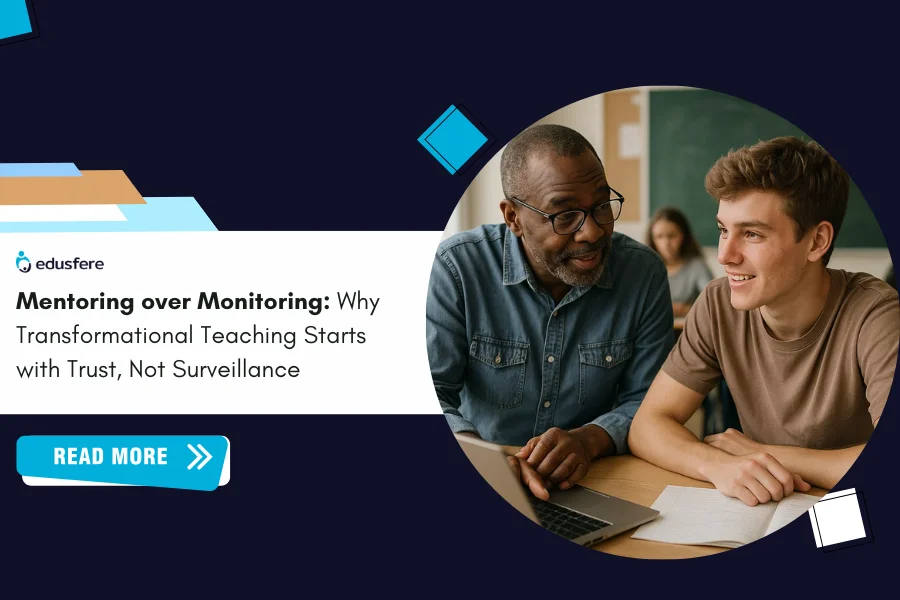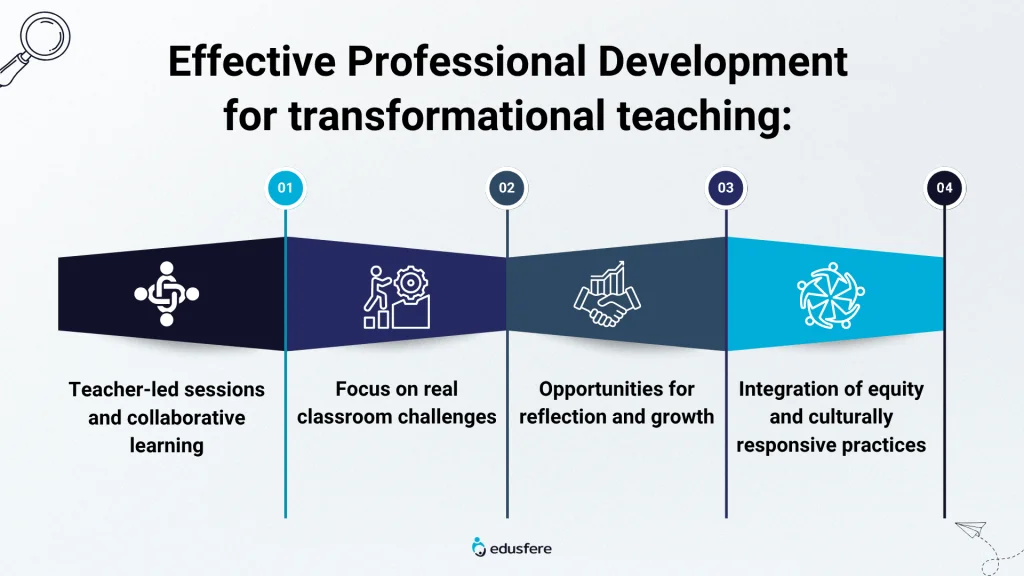Schedule a free demo to learn more
Mentoring over Monitoring: Why Transformational Teaching starts with trust, not surveillance
11th August 2025

It’s tempting to believe that monitoring alone can drive accountability in classrooms given the analytics and surveillance systems available. But transformational teaching, the kind that shapes students into critical thinkers, engaged citizens and lifelong learners, doesn’t thrive under observation. It grows in environments where trust, autonomy and collaboration form the foundation.
As educators and school leaders search for scalable and sustainable change in K-12 education, it’s time to ask a different question- Are we simply monitoring or mentoring minds?
Let’s take a deeper look into why transformational teaching strategies rooted in mentorship, not micromanagement, are more effective for both academic outcomes and teacher satisfaction.
Simultaneously, we will also look at how curriculum management and strategies for professional development for teachers can support this cultural shift, backed by real data and best practices.
What is Transformational Teaching and why it matters in 2025?
Transformational teaching refers to pedagogical methods that go beyond delivering content; they inspire students to explore, reflect and evolve.
Transformational teaching involves creating dynamic relationships between teachers, students and a shared body of knowledge to promote student learning and personal growth. It’s a sharp departure from the transactional model of teach, test, repeat.
Characteristics of Transformational Teaching
- Student-centered learning where instruction adapts to students’ needs and interests.
- High expectations with autonomy where students are challenged and trusted.
- Relationship-based instruction where teachers act as mentors, not monitors.
- Reflective practice where teachers continually evolve based on feedback ad results.
- Emphasis on equity wherein every student is given the tools to succeed, not just those who conform easily.
Why does this matter now?
In contemporary K-12 classrooms, there’s a growing tension between transactional and transformational teaching, a contrast clearly articulated in Inside Higher Ed. As Steven Mintz highlights, transactional teaching emphasizes efficiency, content delivery and compliance wherein teachers lecture, students take notes and learning is measured in rote memorization.
In contrast, transformational teaching seeks to cultivate curiosity, ethical reasoning and intellectual growth, not simply cognitive outcomes. It’s about guiding students to become critically reflective, socially aware and personally engaged thinkers.
Why does that distinction matter today?
The transactional model falls short in addressing pressing challenges in K-12 education: disengaged students, escalating behavioral issues and widening equity gaps. Transformational teaching strategies, anchored in mentorship, inquiry‑based learning and emotional connection, i.e., offer a richer, more human-centered response.
These perceived limits on autonomy correlate with lower job satisfaction and higher attrition.
According to a report, about 8% of public school teachers left the profession between 2020-21 and 2021-22. Among those who exited, 60% cited lack of autonomy or control over their work as a key reason. Teachers reported that new roles outside K-12 often offered better work‑life balance, control over decisions and manageable workloads were some of the demands unmet in highly monitored settings.
In this context, transformational teaching, focused on growth, trust and teacher-driven innovation, is no longer optional; it’s essential. By shifting from surveillance to mentorship, schools can cultivate environments where educators and students both flourish.
How Curriculum Management can support Transformational Teaching
Curriculum management refers to the strategic development, organization and delivery of educational content across grade levels and subjects. When implemented with flexibility and teacher input, it can empower, not restrict transformational teaching.
Centralized Curriculum, Decentralized Voice
While school districts need structured curricula to ensure standards compliance, giving teachers autonomy in how they deliver lessons helps foster creativity and student engagement. Tools like real-time curriculum mapping and feedback loops between teachers and instructional coaches allow room for:
- Incorporating student-led projects
- Using local or community-based examples
- Adapting lesson timing based on classroom pace
Aligning Content with Transformational Teaching Strategies
A 2024 report stated that students performed better in schools where curriculum guidelines encouraged inquiry-based learning, rather than rote instruction. That’s because transformational strategies thrive on exploration, debate and real-world relevance.
Pro Tip: Use digital curriculum management platforms that allow flexible lesson planning and prioritize PD that trains teachers in adaptive teaching techniques, not rigid compliance.
The Role of Trust and Autonomy in Transformational Teaching
Teachers, too, need trust. Micromanaging instructional minutes, mandating rigid pacing guides or tying evaluations solely to test scores creates a fear-based culture. Instead, school leaders can:
- Encourage self-reflection journals for teachers
- Use peer feedback loops instead of just top-down evaluations
- Replace surveillance tools with collaborative coaching
Building a culture of Mentorship through Professional Development for Teachers

To sustain transformational teaching, schools must reimagine professional development for teachers as a mentorship-driven experience, not a checkbox activity.
Peer Coaching vs. Compliance Workshops
Traditional PD often involves sit-and-get sessions on pedagogy. But studies show that job-embedded, ongoing mentorship is more effective. The Learning Policy Institute found that schools using peer coaching models saw a 49% increase in instructional quality and improved student achievement across the board.
Key features of effective PD for transformational teaching:
- Teacher-led sessions and collaborative learning
- Focus on real classroom challenges
- Opportunities for reflection and growth
- Integration of equity and culturally responsive practices
Leadership’s Role in Mentorship Culture
Principals and superintendents set the tone. Mentorship thrives when leaders:
- Share power and decision-making with teachers
- Acknowledge risk-taking and innovation
- Publicly recognize transformational teaching efforts
- Embed PD into weekly schedules, not just summer sessions
When leadership models trust, mentorship becomes the norm, not the exception.
Why Monitoring Alone Doesn’t Work and What to Do Instead
Let’s be clear: data matters. But when monitoring overshadows mentorship, even the most talented teachers retreat into compliance mode. A 2023 U.S. Government Accountability Office (GAO) briefing highlighted that overly prescriptive accountability systems can stifle innovation in public schools, especially in under-resourced districts.
Signs that you’re over-monitoring
- Teachers fear trying new methods unless pre-approved
- Students are passive recipients instead of active learners
- Evaluations focus more on checklist completion than student growth
Mentoring for Better Results
In contrast, mentoring offers:
- Safe environments for experimentation
- Personalized coaching for educators at all levels
- Collaborative lesson planning and real-time feedback
Future-ready Schools Embrace Transformational Teaching
The future of education isn’t in more surveillance cameras, dashboards or digital logs. It lies in relationships, reflective practice and real ownership of the learning process by both students and teachers.
How to begin the shift towards Transformational Teaching?
If you’re a school leader or district official, consider:
- Reallocating PD budgets toward peer mentorship
- Reviewing classroom management policies with student input
- Auditing curriculum tools to ensure flexibility and teacher autonomy
If you’re a teacher, reflect on:
- Where you feel monitored vs. mentored
- Which of your practices best spark student curiosity
- How your school can support, not stifle your growth
Trust is the New Framework
Transformational teaching is not a trend, it’s a necessary shift for schools that want to thrive in a post-pandemic, AI-influenced, and culturally diverse world. That shift begins when we replace top-down monitoring with bottom-up mentoring, building a professional ecosystem where teachers lead and learners grow.
To truly support our schools, we must trust the professionals within them.
Ready to Rethink Teaching Culture?
Transformational teaching isn’t just an instructional shift, it’s a cultural one. And it starts with how we support our educators, design our curriculum and manage our classrooms.
If your school is exploring how to move from monitoring to mentoring, we’d love to help. At Edusfere, we partner with K-12 leaders to build future-ready, teacher-empowered ecosystems through flexible curriculum management tools and mentorship-driven strategies.
Together, let’s create classrooms where trust leads the way!